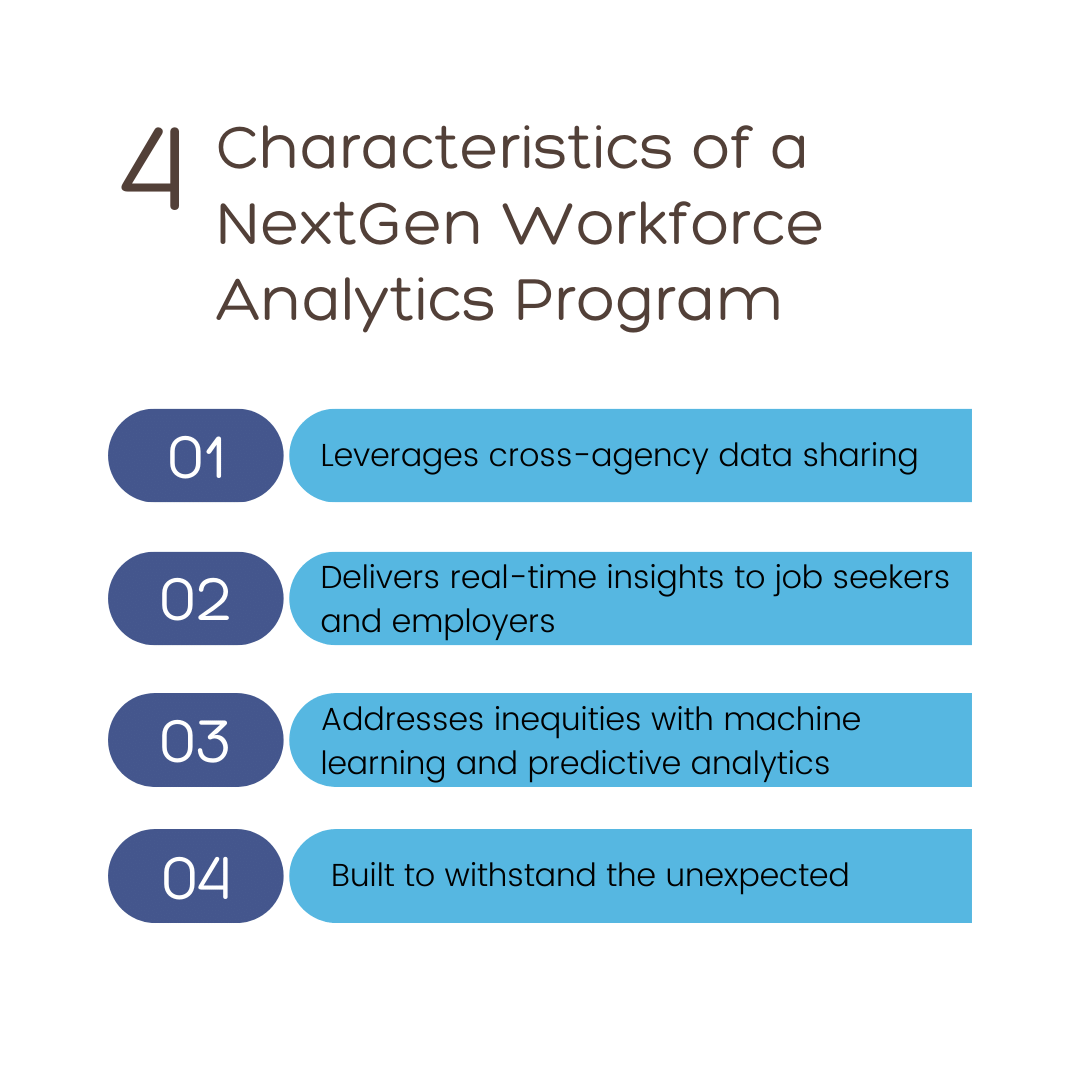How State Governments Can Modernize Workforce Development Programs through Data Analytics
State and local workforce development programs had to rapidly adapt over the past year to help the millions of workers affected by the pandemic. While some of the challenges faced by state leaders were brought to a head by COVID-19 (e.g., an over-reliance on in-person service delivery at career centers), others preceded the pandemic. Workforce development programs and services are often spread across several state agencies, each collecting valuable data about the labor force and job seeker needs.
Unfortunately, this data is often siloed, stored in a wide range of formats, and restricted in use. Without a central data repository, workforce development partners don’t have the full picture needed to best support their communities. Many states also lack the IT and legal infrastructure needed to securely share and analyze data among organizations.
By investing in data analytics and business intelligence, state leaders can make important strides in modernizing workforce development programs so they can better serve constituents now – and prepare for future economic shifts.

State and local workforce development programs had to rapidly adapt over the past year to help the millions of workers affected by the pandemic. While some of the challenges faced by state leaders were brought to a head by COVID-19 (e.g., an over-reliance on in-person service delivery at career centers), others preceded the pandemic. Workforce development programs and services are often spread across several state agencies, each collecting valuable data about the labor force and job seeker needs.
Unfortunately, this data is often siloed, stored in a wide range of formats, and restricted in use. Without a central data repository, workforce development partners don’t have the full picture needed to best support their communities. Many states also lack the IT and legal infrastructure needed to securely share and analyze data among organizations.
By investing in data analytics and business intelligence, state leaders can make important strides in modernizing workforce development programs so they can better serve constituents now – and prepare for future economic shifts.
NextGen Workforce Analytics Programs Leverage Cross-Agency Data Sharing
Current workforce development operations rely on experts in state agencies, career centers, and training facilities. While many of these dedicated professionals have acquired a granular knowledge of local workforce development partners and labor market conditions, there is no mechanism to empirically validate their insights or share notes across programs.
This lack of integration inhibits results at all levels. Field staff can’t access the data necessary to identify promising practices or understand roadblocks specific to their community, while policy makers are forced to rely on incomplete data or theory, not evidence.
Unifying agency-specific systems can seem daunting, but a Data Trust provides the infrastructure to overcome the challenges that have historically impeded cross-agency collaboration on workforce development programs. By providing the rules of engagement among agencies and other entities that share data, a Data Trust ensures transparency, facilitates common understanding, and promotes a culture of collaboration.
In addition to connecting job seekers with the full spectrum of support services, the Data Trust makes it easier for workforce development centers and executive state leadership to coordinate across programs by providing data for tracking and monitoring important metrics about:
- Program enrollment and completion
- Program reentry rates
- Wage and employment status gains
NextGen Workforce Analytics Programs Provide Job Seekers and Employers with Real-Time Insights
A true measure of success is on-the-ground results for job seekers and employers. Workforce development professionals must create solutions that deliver personalized insights to job seekers and employers to help them navigate the changing labor market.
For example, if job seekers had access to accurate, real-time information about the number of job openings in a particular industry, they could better understand which training programs will help them develop in-demand skills. Likewise, if employers had a complete view of state training programs, economic development incentives, and skill sets of the existing regional workforce, they could make more informed investments in their current and future workforce.
NextGen Workforce Analytics Programs Use Machine Learning and Predictive Analytics to Combat Inequities
For too long, disconnected information systems, siloed agencies, and outdated practices have made it difficult for people from disadvantaged backgrounds to take advantage of the programs designed to help them. Machine learning and advanced predictive analytics can improve outcomes for all constituents by helping state leaders analyze data and measure program performance across demographics.
Insights uncovered by these advanced analytics approaches include:
- The strongest predictors of earnings based on demographics and employment history
- The impact of credential attainment on income, social safety benefits, and net earnings potential
- Expected variations in workforce supply/demand that allow state resource agencies to more strategically allocate resources
- The return-on-investment of state-funded and federally-funded training programs
NextGen Workforce Analytics Programs are Built to Withstand the Unexpected
Forward-thinking state leaders know that the pandemic will not be the last unexpected disruption for local economies. Workforce development programs must be prepared for and resilient to rapid market changes – future health emergencies, economic downturns, and technological innovations.
Unfortunately, many state workforce development programs rely on inflexible systems that grow stale quickly and drag program performance with them, often generating huge cost overruns and decreasing in value over time.
To achieve long-term results, state leaders must embrace an agile methodology and focus on continuous improvement:
- Avoid inflexible RFPs and prioritize scalability by leveraging cloud-based platforms, automation, and machine learning
- Consistently identify new ways to combine, understand, and use the state’s collective data
- Invest in open data solutions that align with job seekers’ digital behaviors (e.g. mobile first solutions)
- Use rapid prototyping to collect feedback quickly and optimize user experience for policymakers, employers, and job seekers

